Building SASKATCHEWAN


• Mentorship matters • Four generations of union pride • Addressing Saskatchewan’s labour challenges • Women in Trades and Technology hits the road • Saskatchewan Indian Institute of Technologies innovates in the trades 2023 PUBLICATIONS MAIL AGREEMENT #40934510
train and retain your workforce.

SaskJobs Employer Services provides businesses with a full range of services related to workforce needs. No matter your request, we can connect you to the right resources. From training subsidies to immigration recruitment supports, we have you covered by guiding you on Source, Recruit, Train and Retain strategies and best practices.
Visit our popular job board, saskjobs.ca, to post your jobs and connect with your needed talent.
Get in touch with SaskJobs Employer Services today by calling 1-833-613-0485, emailing saskjobs@gov.sk.ca or visiting us online at saskatchewan.ca/employer-services.
saskatchewan.ca
Hereto help your businesses source, recruit,
is published by DEL Communications Inc. Suite 300, 6 Roslyn Road Winnipeg, Manitoba Canada R3L 0G5
President & CEO
DAVID LANGSTAFF
Managing Editor LYNDON MCLEAN lyndon@delcommunications.com
Advertising Sales Manager
DAYNA OULION
Account Representatives

BRENT ASTROPE
BRIAN GEROW
ESHAAN REVIS
ANTHONY ROMEO
Production Services S.G. Bennett Marketing Services
Creative Director / Design
KATHLEEN CABLE
©DEL Communications Inc. All rights reserved. Contents may not be reproduced by any means, in whole or in part, without the prior written permission of the publisher Publications mail agreement #40934510
Return undeliverable address to: DEL Communications Inc. Suite 300, 6 Roslyn Road Winnipeg, MB R3L 0G5
While every effort has been made to ensure the accuracy of the information contained herein and the reliability of the source, the publisher in no way guarantees nor warrants the information and is not responsible for errors, omissions or statements made by advertisers. Opinions and recommendations made by contributors or advertisers are not necessarily those of the publisher, its directors, officers or employees.
3 Building Saskatchewan
PRINTED IN CANADA 01/2023
BAC Local 1 7 BC Building Trades Council 7 Best Western Plus Airport Inn & Suites 46 BFI Constructors 9 Building Trades of Alberta 5 Canada’s Building Trades Unions OBC CLR 8 Construction Opportunities Development Council Inc. 12 Coronet Hotel Prince Albert 46 D3H Hotels 44 Delta Hotel By Marriott –Bessborough/Saskatoon Downtown 46 Gold Eagle Lodge 45 International Association of Heat & Frost Insulators & Allied Workers Local 119 25 LiUNA 15 Manitoba Building Trades 33 Mosaic 20 Operative Plasterers & Cement Masons Local No. 222 ..... 13 PM Signs 31 Prince Albert Inn 44 SaskJobs IFC Saskatchewan Apprenticeship and Trade 19 Saskatchewan Construction Safety Association 17 Saskatchewan Federation of Labour 27 Saskatchewan Indian Institute of Technologies 35 SaskInteractive 7 SaskTel IBC Smart Canada 43 Smart Local No. 296 33 Teamsters Local Union No. 395 13 Trades NL ....................................................................................... 13 UA Local No. 179 5 Union Savings 37 Message from Trades President Wayne Worrall 4 Message from SBT Executive Director Dion Malakoff ............................................ 6 Message from Sean Strickland, Executive Director of Canada’s Building Trades Unions ......................................... 8 Message from Minister of Immigration and Career Training Jeremy Harrison .......................................................................... 10 Improved training and safety with virtual reality 11 CODC: More than just alcohol and drug policy 12 What to look for in pension plans ........................................................................... 14 Shifting ground in construction 16 Tiny homes project brings shelter and skills to Indigenous communities 18 PRO Care Employee and Family Assistance Program .......................................... 21 Women in Trades and Technology hits the road 22 Profile: Four generations of union pride 24 Sask Building Trades’ new website showcases what the trades have to offer 26 New thinking needed to address Saskatchewan’s labour challenges 28 Advancing women in the trades 30 Mentorship matters 32 Saskatchewan Indian Institute of Technologies innovates in the trades 34 There’s a great future in the trades........................................................................36 Canadian CCS leadership: An opportunity too important to lose 38 SMART celebrates 70 years of roofing in Canada 42 Hotel guide............................................................................................................. 44
Building SASKATCHEWAN
In this issue
Index to advertisers
MESSAGE FROM TRADES PRESIDENT WAYNE WORRALL
Trades recruitment

The Building Trades and its member unions are ramping up their efforts in increase market share by bringing in new members and organizing companies which want a steady, predictable labour pool.
“We've had the Build Together program for years,” says Trades President Wayne Worrall. “This is a workforce development program focusing on recruiting and retaining workers from underrepresented portions of the population, such as women, Indigenous people, new Canadians, and the next generation of building trades workers.”
“We're also aggressively working with companies to explain the benefits of having a unionized work force.”
One unexpected source of new workers are refugees coming into the province since Russia invaded the Ukraine in February 2022. “We have a big contingent of Ukrainian, Russian and Slovakians coming to Saskatchewan who are looking for work. The Building Trades are an important option for them.” Over 2,000 refugees have come into the province, and more are on their way.
The federal government recently announced it was increasing immigration to 500,000 people each year for the next three years, with an emphasis on skilled labour.
“A career in the Building Trades can offer better wages and benefits and a more secure living,” Worrall adds.
One of the drivers of the effort to increase market share is the retiring out of the Baby Boom generation, the largest demographic in Canadian history.
“Matching our membership with the number of jobs available is a constant concern,” says Worrall. “We need
to live up to our commitment to employers to provide a large, skilled workforce and also make sure our members have work.”
COVID has only made the problem worse.
“We lost a lot of members who chose to retire, particularly during the lock down. Good for them – it's their lifestyle choice, but it means we've got to redouble our efforts to not only keep up our market share, but to increase it.”
The Building Trades Indigenous outreach work er Lyle Daniels has moved to Alberta and will be replaced in November of 2022.
“Indigenous workers are the biggest growing demographic in the province, and we've had good success in convincing them that the Trades offer great pay and benefits, job security and ongoing training. When we go to high schools and tell the students they can start their apprenticeship making $20 an hour to start, they get very interested. This is a lot better than getting a degree and coming out $20,000 in debt.”
As labour shortages intensify, the Building Trades and its member unions are looking at smaller companies who are having trouble recruiting in a time of national labour shortages. “We position ourselves in the market by saying to them – we can help you; we have the workforce you're struggling to put together.”
“This is an ongoing effort,” Worrall concludes. “We just have to go ahead and do it. We know the market and we know who the employers are. By convincing the smaller companies we can help them, we all move forward. It's a win-win for both contractors and unions.”
4 Saskatchewan Building Trades
United Association of Journeymen and Apprentices of the Pipe Trades Industry of the United States and Canada or “UA” as it is commonly known is a multicraft union whose members are engaged in the fabrication, installation and servicing of piping systems. There are approximately 326,000 highly-skilled United Association members who belong to over 300 individual local unions across North America.
The United Association has been training qualified pipe tradesmen longer than anyone else in the industry. The UA boasts the premier training programs available in the industry today, including five-year apprenticeship programs, extensive journeyman training, organized instructor training, and certification programs. United Association Local 179’s objective is to represent all workers in the Pipe Trades Industry (Plumbers, Pipefitters/Steamfitters, Welders, Refrigeration, Sprinklerfitting, Instrumentation, etc.) and to work together as partners with our contractors to provide the highest standards of quality workmanship and production for their clients in the Province of Saskatchewan.
On September 1, 1906 the United Association issued the charter for Local 179. This charter charges the membership of Local 179 with the obligation to protect the trade jurisdiction of the United Association in the plumbing and pipefitting industry in the Province of Saskatchewan and to extend the influence of the United Association to embrace all individuals employed in the plumbing and pipefitting industry in Saskatchewan.
To achieve this goal we must supply our contractors with highly skilled and dedicated tradesmen committed to providing the highest standards of quality workmanship and production. We must work together as partners with our contractors to make them the preferred choice with the clients. We must use creative and innovative strategies to bring all piping trade workers in Saskatchewan into the United Association.
It is through these actions that we will be able to achieve the benefits we rightfully deserve as fair compensation for our labour. These benefits include job security, health and welfare benefits, a living wage, a safe working environment, and a comfortable pension. We will only have achieved our mission when every individual in the Province of Saskatchewan who earns their living by working in the plumbing or pipefitting industry is a member of the United Association.
| CANADIAN PIPING TRADES






5 Building Saskatchewan
STANDARD FOR SAFETY PROUDLY SASKATCHEWAN
no substitute
a UA Craftperson!
B T A c o o r d i n a t e s a n d p r o m o t e s t h e i n t e r e s t s o f 1 8 A l b e r t a l o c a l s k i l l e d t r a d e s u n i o n s , w h o s e m o r e t h a n 6 0 , 0 0 0 m e m b e r s w o r k i n t h e r e s i d e n t i a l , c o m m e r c i a l , m a i n t e n a n c e a n d f a b r i c a t i o n i n d u s t r i e s
There is
for
UALOCAL179.CA
MESSAGE FROM EXECUTIVE DIRECTOR DION MALAKOFF
Goverment and the trades
One of the key roles of the Saskatchewan Building Trades is working with governments at all levels for the benefit of our members.
“All three levels of government – federal, provincial and municipal – are involved in the construction industry, as regulators, training providers and as project managers,” says Trades President Dion Malakoff.
Government-funded institutions account for one-third of non-residential construction activity.
“For example, in Regina alone, city council is considering four major construction projects: a new aquatic facility, a redesigned/rebuilt central library, a new hockey rink for the Pats, and a new baseball and soccer facility,” he notes. “A public consultation is underway to determine what to build and when, but whenever they go ahead, we will be available to build them. And that’s just Regina. As infrastructure ages, all three levels of government will go about rebuilding or rehabbing projects across the province.”
The roles among the three levels of government break down as follows.
Federal
The federal government develops model national building codes for construction and establishes parameters for federal environmental assessments, a critical step before shovels go into the ground. In addition, the federal government sets the rules for when foreign workers can be used on Canadian construction sites. The Saskatchewan Building Trades always advocates for Saskatchewan workers to be the first source of skilled labour on Saskatchewan construction sites, followed by building trades from other provinces, and, finally, other countries. The federal government also provides funding for the purchase of equipment to train our members.
Provincial
The Government of Saskatchewan establishes the provincial
construction codes, labour standards, environmental regulations, and parameters for municipal zoning regulations (under the Constitution of Canada, provinces are responsible for organizing municipalities and overseeing their development.) The provincial government, including provincially owned Crown Corporations such as SaskPower, also controls large capital budgets. Building Trades members will be needed as SaskPower transitions their power production to greener energy sources. As always, Saskatchewan workers should be the first hired and the last laid off from construction sites funded by provincial tax dollars.
Municipal
The many municipal governments of Saskatchewan – urban and rural – set their own zoning requirements, approve building applications, issue building permits, and conduct building inspections. Many of the construction projects our members work on are located outside of our urban centres. Building Trades members are an important source of economic activity associated with construction projects in many communities across Saskatchewan.
“It can be challenging for contractors to work with three levels of government that all set environmental regulations and have varying responsibilities on-site, but the result is worth it,” Malakoff continues. “Governments tend to be more stable than the private sector and will often initiate construction projects when the private sector is stepping back. The nature of government projects fits nicely into our specialty – providing skilled workers to build large industrial projects. This not only benefits us, but society as a whole as we build their schools, hospitals, and other public buildings.”
“At the Saskatchewan Building Trades, it is our job to actively engage with all levels of government for the benefit of our members, contractors, and owners,” says Malakoff. “We make sure that all governments take our members’ interests in to account when they make decisions.”
6 Saskatchewan Building Trades
www.saskinteractive.com
info@saskinteractive.com
1645 Reynolds St., Regina, SK S4N 6J1 Phone: 306-359-6356

FOLLOW US:

FOLLOW US: @baclocal1sk
@baclocal1sk
BAC Local #1 Saskatchewan
www.bac1sk.ca
BAC Local #1 Saskatchewan

FAS Admin. Benefits & Pension
www.bac1sk.ca

Toll Free 1-800-770-2998
FAS Admin. Benefits & Pension
Toll Free 1-800-770-2998
7 Building Saskatchewan
ADVOCACY EDUCATION NETWORKING
MESSAGE FROM THE EXECUTIVE DIRECTOR OF CANADA’S BUILDING
TRADES UNIONS
Canada’s skilled trades workforce: Planning for the future
By Sean Strickland, Executive Director,

Over the past year, the construction sector has seen a series of investments and major projects announced. There has been a renewed focus on building Canada’s skilled trades workforce and ensuring that the workforce is diverse and inclusive. Investments made at the federal level, and in many provinces, recognize the value of apprenticeship training and what a career in the skilled trades can offer. This at a time when our economy is transitioning to meet net-zero targets which will require us, as the Building Trades, to focus on new and emerging technologies that will create work opportunities for our members and ensure that we’re ready and waiting to build Canada’s net-zero future. We recognize the drive to net-zero will require the construction of new technologies while at the same time, continuing to support our existing oil and gas industries. With the
Canada’s Building Trades Unions

investments and tax incentives being introduced by the federal government, tying these to good union jobs, high labour standards, and prevailing wage will raise the bar for all of us while growing Canada’s skilled trades workforce.
Because we know by the numbers that there will be challenges.
According to BuildForce Canada’s outlook, our industry needs to recruit an additional 29,000 workers to replace retirees and meet the demand profile for future construction by 2027.
Understanding this, for over a decade, Canada’s Building Trades Unions have focused on building a more diverse and inclusive workforce. Our apprenticeship and training systems are the cornerstone of unionized construction; our unions and signatory
contractor partners invest over $300 million in private sector money to fund and operate over 195 training centres that produce the safest, most highly trained, and productive skilled craft workers found anywhere in the world.
And we’ve worked closely with the federal government to ensure strong investments have been made to support training and apprenticeships.
Take, for instance, the 2022 Federal Budget. The immediate need to address labour availability was made easier by the Labour Mobility Tax Deduction included in Budget 2022. For years, construction tradespeople have had to labour under a particularly unfair section of the Income Tax Act that prohibited them from deducting their travel expenses when they had to relocate to work at construction sites. Because, we know, that the nature of construction is cyclical – with an abundance of work in some regions and high unemployment in others.
Labour shortages cause project delays, ultimately higher costs, and affect productivity.
If anyone who has had to travel to work deserved to deduct their expenses, it would be skilled tradespeople. Which is why – after a long fight that included over two decades of advocacy, and
8 Saskatchewan Building Trades
www.clrs.org 306-352-7909 AN EMPLOYER’S ORGANIZATION Building Relationships Sharing Knowledge Representing Employers
many private members’ bills – all three major parties during the 2021 election saw the common sense in amending the act, and now, it’s inclusion in the budget. So thank you to all those who sent letters or contacted their Member of Parliament. Your involvement made this possible, and the leadership of Saskatchewan Building Trades was an integral part of making this happen.
The tax deduction applies for up to $4,000 in eligible expenses, and workers should keep receipts from the beginning of 2022 onward.
Investments in training and apprenticeships have allowed us to launch programs like the development of a virtual recruitment and assessment portal – coined the Construction Trades Hub – that offers those interested in the trades a chance to explore the multitude of career options, increase their knowledge base through the learning portal, and connect with a local union in their region to further explore opportunities.
Saskatchewan Building Trades, through this project, has a unique provincial portal that connects those interested with province-specific information – an important tool that should be utilized by all our locals and training directors from coast to coast.
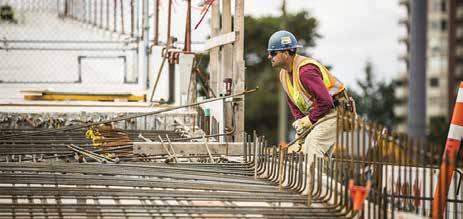

Just this spring, CBTU was awarded a project under the new federal Apprenticeship Service. The Government of Canada is investing close to $247 million in 13 projects that will enable small and mediumsized employers (SMEs) to offer apprenticeship training opportunities; CBTU will work with our employers and apprenticeship bodies to place 4,000 apprentices over the next two years.
More recently, the Fall Economic
Statement detailed key investments on renewable technologies like small modular reactors, carbon capture and storage, and hydrogen. All of these will position Canada as a leader in these areas, which means more investments, more major projects, and more opportunities for Building Trades members to go to work and to create more apprenticeship opportunities. It also included a $250 million commitment over five years to Employment and Social Development Canada to help ensure Canadian workers can thrive in a changing global economy. Supporting workers as we transition to net-zero is also vital in ensuring a prosperous economic future for Canada. Commitments like a new sustainable job stream under the Union Training and Innovation Program (UTIP) and the creation of a Sustainable Jobs Centre and Sustainable Jobs Secretariat are steps in the right direction.
That doesn’t mean our work is done – as these investments are made, funding from the federal government
should be tied to good union jobs. That means a prevailing wage comparative to a full multi-employer negotiated collective agreement with pension, benefits, health, and welfare included must be included. Provisions around apprenticeship hiring and equitydeserving groups will build the workforce we need. Canadians expect this when government makes large investments of public funds, and Canada’s Building Trades Unions stand ready to work with the government to ensure investments made maximize opportunities for more Canadians. Through advocacy efforts and your support, Canada’s Building Trades Unions are committed to continuing to improve the lives of Canada’s skilled trades workers and their families. And we need your help to make it happen. I would encourage you to sign up for our newsletter to keep up to date on national issues – including how to use the tax deduction – by signing up at www.buildingtrades.ca.
Value on display. Every day.
9 Building Saskatchewan
#111, 4208 - 97th Street NW, Edmonton, AB T6E 5Z9 TF: 1-888-485-2703 | T: 780-485-2703 | E: info@bficonstructors.com From oil sands, power plants and ethanol facilities to gas turbines,
and
mines, BFI’s
are
on showcase projects across Canada. Join our team | www.bficonstructors.com WITH THE RIGHT PEOPLE ON OUR TEAM, WE CAN BUILD ANYTHING.
gold
potash
unionized construction teams
found
MESSAGE FROM MINISTER OF IMMIGRATION AND CAREER TRAINING

Jeremy Harrison
Saskatchewan is growing. As our province works to solidify its position as a critical supplier of the food, fuel, and fertilizer the world needs, we are facing challenges associated with this growth. Labour demand is growing, vital infrastructure is needed, and there are fewer workers available to fill vacant positions in many different sectors. The Government of Saskatchewan is meeting these challenges head-on by taking steps to grow the province’s population while creating critical and effective supports for employers to recruit, train, and retain new hires.
Saskatchewan remains an attractive jurisdiction for investment, with over $10 billion in private sector capital investments made in the province since the start of 2021, creating thousands of jobs across all sectors. From forestry and pulp products to biofuels, potash, and value-added agriculture, Saskatchewan continues to grow across a variety of resource sectors.
As these sectors expand, the provincial government is working to provide programs and services to support employers as they grow their workforce, particularly in trade occupations. The demand for skilled trades is driven primarily by economic growth, and we are anticipating increased demand for apprentices and skilled tradespeople in Saskatchewan, especially in the construction sector. Taking recent public and private infrastructure announcements into consideration, these projects will create over 10,000 construction jobs and over 2,300
permanent jobs once construction is complete.
Saskatchewan owes much of its success and continued growth to the men and women in our skilled trades, and our government is committed to providing training opportunities through our post-secondary institutions and partner organizations. We are working to ensure training is aligned to demand and there is sufficient training capacity across the province. These investments in skilled trades training will ensure more apprentices move through the system at a faster rate, creating the skilled workforce needed to meet current and future demand.
As our province faces the challenge of creating a skilled workforce, Saskatchewan is turning its attention to immigration for both population growth and labour supply for healthcare, the service sector, construction, and trades. In the past year alone, the province continues to hit important population targets, with September marking the largest ever quarterly population increase since records began in 1971 for Saskatchewan. In early December, Saskatchewan also reached a record milestone of 1.2 million people calling our province home, further improving labour market prospects as the province moves closer to reaching a provincial population of 1.4 million people by 2030, as laid out in Saskatchewan’s Growth Plan.
With this increase in population, Saskatchewan is investing heavily in capital projects and infrastructure
to house, educate, and provide vital services for newcomers to the province. As foreign worker accessibility grows, the availability of international talent is growing even faster. That is why employers are now seeking internationally skilled workers for vital roles. With provincial programs, such as the Saskatchewan Immigrant Nominee Program, on their side, employers can access some of the highest quality candidates from around the world to meet the needs of their businesses. To assist in a smoother transition for these newcomers, Saskatchewan has also recently introduced the Labour Mobility and Fair Registration Practices Regulations, which will reduce administrative credential recognition barriers faced by workers from other provinces and those trained internationally. This enables them to work in regulated occupations, such as trades, much faster.
It remains ever important for Saskatchewan to ensure a strong and resilient labour market that is equipped with the skills and tools needed to succeed. Our government will continue to invest in a workforce that meets the needs of employers and the people of Saskatchewan. We’ll do this by growing our province’s population, creating valuable employer supports, and maximizing training capacity for many in-demand positions.
Saskatchewan is well-positioned for the future, and we look forward to what comes next.
10 Saskatchewan Building Trades
Improved training and safety with virtual reality
Provided by SaskInteractive
When you first look at the interactive digital media (IDM) sector, you might not think that there is much cross-over with the building and trade industries. However, in recent years there have been many developments in technology that are both practical and applicable to the building and trades industries. Interactive digital media technology is now bringing advances in safety and training measures using augmented reality (AR) and virtual reality (VR) training programs.
So what are VR and AR exactly?
Virtual reality is a computer-generated simulation of an environment created with software, which can be experienced through a special headset or headset-like device that combines video content with interactive simulations. Augmented reality will not replace your surroundings with a digital one, but instead will add digital elements through a lens or camera to your live surroundings.
How can digital programs and software help those who work in the physical trades?
In the past few years, VR and AR have become a very popular technology that are being used to train workers on many levels before they begin work on jobsites. While VR and AR programs are still new, they’re becoming increasingly more popular because they improve the worker’s training experience.
One of the most obvious benefits of AR and VR technology is the ability to provide a safe space while employees undergo training. Using both technologies can increase worker engagement and interest while providing a safe environment to practice vital skills before attempting them in real-life scenarios. By simulating a hands-on experience through either VR or AR, you can keep employees safe while providing the necessary training that is required in the trades. Being able to learn in a virtual environment can remove the risk associated with learning certain skills, such as using heavy machinery or climbing ladders and working at heights. AR and VR allow for employees to make mistakes while risks
are minimized or eliminated – meaning workers are at ease while training, and less stress leads to a better learning environment.
Another major benefit to using AR and VR training tools is improved memory retention and an overall reduction in the time it takes to train employees. The old adage of learning by doing is applicable, and your brain forms pathways when applying training via AR or VR that leads to quicker uptake by employees.

These methods of training are also more engaging than traditional learning methods. Keeping employees motivated and interested in learning also helps with knowledge retention and uptake. When workers use these tools to learn, it has been found that most employees learn how to operate on jobsites more efficiently. This leads to less training time required with better results, which also helps to lower the costs associated with training.
The field of VR and AR training tools is fairly new, but it is growing quickly. Whether you’re looking to improve the safety of your management, or simply maintain your buildings, VR is proving to be a useful tool. It’s likely only a matter of time before this tech will become more widely used throughout the building trades in Saskatchewan.
11 Building Saskatchewan
CODC: More than just alcohol and drug policy

For many workers of the Saskatchewan Provincial Building and Construction Trades Council, the term “CODC” is synonymous with one thing: alcohol and drug tests. But the two co-Chairs of the Construction Opportunities Development Council Inc. (CODC), Dion Malakoff (SPB&CTC Co-Chair) and Warren Douglas (CLR Saskatchewan Co-Chair), want to highlight that the CODC does so much more.
The CODC was jointly founded as a not-for-profit organization in 1994 between the CLR and the SPB&CTC as a vehicle for unions and contractors to collaborate on industry matters and to promote our industry to owners,

clients, stakeholders, and the public. The CODC is funded by employers through a cents-per-hour contribution, aside from the wage package that the workers receive. These contributions have been negotiated into the various trade collective agreements. This funding allows the CODC to undertake a variety of initiatives to support the unionized workers, unions, and employers in Saskatchewan.
First, the CODC has undertaken research and surveys of construction owners and clients to find out how the unionized construction sector is viewed and to learn about what we as an industry needed to do to
improve ourselves and make us a more attractive option. Further, the CODC has underwritten the costs of industry-wide negotiations, also known as “Big Table”, as well as for various project agreements that have occurred over the years. The CODC has also hosted conferences and meetings for unions and contractors to jointly find solutions to some industry issues.
Next, the CODC offers its members (workers, unions, and employers alike) a variety of training including online training such as Rights and Responsibilities (OH&S Awareness training), Safety Construction Orientation Training (SCOT), leadership training for Forepersons (Better SuperVision), Indigenous Awareness Training as well as the A&D Policy training for Supervisors and Stewards course. The CODC is also a vendor for BuildForce Canada’s online courses and will be rolling out more of those courses in the coming months.
The CODC also actively supports its contractors and unions in recruitment initiatives. The CODC worked with Canada’s Building Trades and the local Build Together (Women in the Building Trades) chapter to launch Build Together – Saskatchewan, an effort to bring more women, indigenous peoples, new Canadians, and youth into our industry. Warren

12 Saskatchewan Building Trades
Proud
CODC Construction Opportunities Development Council Inc. 600 – 4010 Pasqua Street Regina, SK S4S 7B9 Tel: (306) 347-7299 | Fax: (306) 352-8081 Email: info@codc.ca
to support our workers and their families in Saskatchewan by providing education and training, career opportunities and our PRO Care Employee and Family Assistance Plan.
Douglas, CLR Co-Chair, is pleased to note that starting in 2023, the CODC will have a dedicated marketing and recruitment coordinator to focus on promoting and connecting people to jobs in the unionized construction and maintenance industry.

On the personal front, through the CODC, members of the unions enjoy access to an Employee Family Assistance Program, under the name of Pro Care. This free access to EFAP/EAP services is available for workers and their families, so long as they remain actively working in the province under one of our collective agreements. Services offered include counselling for family issues, financial and legal challenges, separation and divorce, anger management, depression, bereavement and grieving, substance dependency, and more. If you are having such challenges, you are encouraged to access this free and confidential service for you and your family by calling 1-866-757-6620.
Another service that the CODC offers its stakeholders is jointly developed and supported policies that have been developed collaboratively by both contractors and unions. Examples of such policies include the Harassment Policy, COVID-related policies and of
are available for download on the CODC’s website.
course, the Alcohol and Drug Policy. All of these are available for download on the CODC’s website.
Lastly, the CODC builds connections in the community and supports related organizations that align with the CODC’s interests. The CODC supports the Saskatchewan Apprenticeship and Trade Certification Commission (SATCC) through its annual apprenticeship awards, as well as offering a Saskatchewan Youth Apprenticeship Scholarship for high school students exploring the trades as a career option. Also, this year, the
CODC sponsored the Miyo-Wiciwitowin Day (meaning reconciliation in Cree) in Regina at Mosaic Stadium on September 29th. This event brought together youth and community leaders for an event that included survivor stories, music, dance, keynote speakers and presentations to advance the 94 calls to action by the Truth and Reconciliation Commission. To learn more about the CODC or to download some of our available documents, visit our website at www.codc.ca.
Operative Plasterers’ & Cement Masons’ Local 222
George Emery
Business Manager/Financial Secretary
Head Office
17307 - 106 Ave NW
Edmonton AB, T5S 1E7
Ph: (780) 423-4296
Fax: (780) 423-4271
Cell: (780) 446-3060
george@local222.com
www.local222.com
Calgary (403) 258-0042
Saskatoon (306) 244-6556
Winnipeg (877) 423-4296

13 Building
Saskatchewan
Examples of such policies include the Harassment Policy, COVIDrelated policies and of course, the Alcohol and Drug Policy. All of these
What to look for in pension plans
With some exceptions, pensions are provincially regulated, meaning employees are subject to the provincial laws where they report to work. Workers in federally regulated jobs (i.e. airlines or grain handling) fall under federal government rules so they are subject to federal law. Also, some Saskatchewan Government employee pension plans have their own legislation.
The Pension Benefits Act is the law that covers all the pension plans registered in Saskatchewan. The rules of the Act ensure the fair and equitable treatment of plan members and establish the rules under which pension plans must operate.
The Pension Benefits Act sets out certain things that the pension plan must do and certain things that regulators (such as the Financial and Consumer Affairs Authority of Saskatchewan) must do.
Among other things, The Pension Benefits Act states that:
• all registered pension plans have to comply with the law;
• amendments to plans have to be filed with the regulator’s office;
• employers must make their required contributions. For defined benefit plans, required contributions are determined by an actuary, who performs an actuarial valuation report at least every three years;
• every plan has to submit an annual information return, which gives updated information about the plan; and
• all members are provided with annual statements. For defined contribution members, the statement will show members how much is in their account. For defined benefit members, the statement will show how much members can expect to receive from the plan at retirement.
Types of pension plans
There are two main types of plans: defined contribution and defined benefit. There are also limited liability plans, commonly known as target benefit plans.
Defined contribution
In a defined contribution plan, a contract defines how much the employee puts in and how much the employer puts in. A certain amount of your pay is put in the pension plan and is invested. That money accumulates over time, much like an RRSP (Registered Retirement Savings Plan).
When you retire, you have a lump sum of money. The plan member then decides what to do with it. [How can I invest that? How can I ensure that I will have enough money for the rest of my life?]
The Act provides a few options as to the products the money can be put in, such as a locked-in retirement account or an annuity.
Many members are interested in tools to help them understand and estimate their benefits upon retirement, and to that end, plan administrators could provide estimates of the accumulated value members will have at retirement and the pension that may result from that value.
Defined benefit
In essence, a defined benefit plan works the opposite of a defined contribution plan. In these plans, there’s a contract that specifies how much you’re going to get when you retire.
A typical plan will pay 1.5 per cent of your average income multiplied by years of employment. The best plans are two per cent plans – if you work 35 years, you’ll get 70 per cent of your salary when you retire. With the formula, administrators figure out how much it’s going to cost.
The contribution amounts float, but the pension formula is static. Every three years, the plan files an actuarial valuation report. It uses current economic data and assumptions about life expectancy to determine the cost of the pensions earned to date. It also determines the cost of benefits going forward.
Target benefit plans
The third type of plan – a hybrid of the first two – is a target
14 Saskatchewan Building Trades
benefit plan. In these plans, contributions are fixed (like in a defined contribution plan). At retirement, plan members will receive a pension directly from the pension plan based on a formula (like in a defined benefit plan). However, if the plan is in a deficit position, rather than contributions going up, as would happen in a defined benefit plan, benefits are reduced.
There has been a national trend toward the introduction of more target benefit plans. Saskatchewan has had several of these plans registered for many years.
Pension plans for the building trades unions are typically target benefit plans with several employers contributing to the plan.

Generally speaking, older plans are defined benefit and newer plans are defined contribution. The number of defined benefit plans has been declining over time, and the trend is toward more defined contribution plans.
Pension members should be aware of what type of pension plan they’re in. Particularly for defined contribution plan members, it’s important to have an idea how much money your plan is likely to provide you when you retire so you know if you need to save more money in a personal account, like an RRSP.
Plan members should be aware of their rights – like how much will their spouse be entitled to when the member dies, what happens if you leave your job, and what happens when you retire. The plan administrator will have a plan booklet available for members, which will answer these questions.
No guarantee
There is always a possibility of low investment returns. Even in a well-managed portfolio of investments, external factors can result in poor returns. In defined contribution plans, poor investment performance may result in members having lower-than-expected account balances at retirement. In defined benefit plans, poor investment performance may result in higher contribution requirements or, in some cases, the reduction of benefits.
Sometimes pension plans aren’t intended to be a replacement for your salary – not the only source of income when you retire. You should have some idea of what you’re going to get and determine if you should supplement your pension with other savings, like RRSP contributions or TFSA (Tax-Free Savings Account) contributions.
Every pension plan must send an annual statement to their members, who should be looking at how the plan is doing, especially in a defined contribution plan.

If members have any questions, they should contact their plan administrator.
Financial and Consumer Affairs Authority of Saskatchewan, a Treasury Board Crown corporation, is available to help plan members if they feel they’re not being treated fairly or if they feel their plan administrator isn’t complying with pension law or the pension plan contract. They answer inquiries from plan members and plan administrators and also handle complaints.
15 Building Saskatchewan
Construction & General Workers’ Union LOCAL 180 Proudly Serving Saskatchewan Since 1953 2206 Emmett Hall Road, Regina, SK S4N 3N3 306-525-2336 • www.local180.ca SUITE 300, 6 ROSLYN ROAD, WINNIPEG, MANITOBA, CANADA www.delcommunications.com WE OFFER OUTSTANDING PERSONAL SERVICE AND QUALITY IN THE AREAS OF: • Creative Design • Advertising sales • Trade Publications • Video Production & Editing • Qualified Sales & Editorial Team DEL Communications Inc. YOUR KEY TO SUCCESS.
Shifting ground in construction
By Collin Pullar, President, Saskatchewan
Construction Safety Association
When opening the overhead compartment after an airplane flight, passengers are urged to be cautious as luggage may have shifted. Many have likely not set foot on a plane in the last two years, or are just getting back to resuming regular travel, but this caution comes to mind as we emerge and recover from the global pandemic. Certain things have shifted and will affect our industry going forward.
We’ve adapted to uncertainty, new safety precautions, challenges, and adversity in an unprecedented time. The building trades continued with essential, quality work through each wave of the pandemic. The importance of public safety came to the forefront, and it reinforced for us the importance of protecting everyone’s well-being at work.
The Safety Plateau
Injury rates for construction trades have declined in the last decade. Though these rates have been trending in the right direction, statistics show injuries have hit a plateau in recent years. Every statistic represents someone who went to work and was impacted by a workplace incident or accident. These injuries are largely preventable.
For new and young workers entering the building trades, their risk of
injury is greater. According to the Saskatchewan Workers’ Compensation Board, three in five injuries happen to those under the age of 35.1 The most common injuries by far are to the hands, followed by the back and legs. Proper training, hazard controls, and PPE are crucial in bringing these rates down, but the example set by peers can also make a difference.
Inexperienced workers need training, need to know their rights, and need to be supported in building good safety habits. Experienced tradespersons are highly skilled, educated on the importance of good safety practices, and primed to show exemplary safety leadership on the worksite.
Data and Culture
Living in a digital age with a wealth of information at our fingertips, we can use research and data analytics to find areas in health and safety programs that need improvement before injuries occur. This information can help protect workers and inform better decisions around safety practices.
The SCSA has an analytics program that every member company can access at no cost, so it is available on every job site in Saskatchewan. This powerful tool shows that participation in SCSA training and a culture of continuous learning correspond with

better safety records. Positive safety culture and management involvement in safety programs also correlate with a lower risk of time loss injuries.

Safety culture considers if ongoing safety improvement is valued, if safety is as important as production and quality, if workers are involved in decisions concerning safety, and if good safety practices are rewarded.
Hidden Injuries
Mental health is a growing concern on worksites. The nature of working in construction has psychological impacts – long hours, physical exhaustion, seasonal work, and a competitive culture where feelings or stresses are not often discussed. The industry has one of the highest rates of suicide, and many do not reach out for help when experiencing mental distress. 2
According to the Mental Health Commission of Canada, those in construction occupations “experience high rates of suicide due to economic uncertainty, mental health stigma, social isolation and loneliness, increased alcohol consumption, poor working conditions, and a lack of access to mental health services.” 3
Workplace safety goes beyond physical hazards and PPE.
16 Saskatchewan Building Trades
Psychological demands and symptoms of anxiety, chronic stress, loneliness or depression need as much awareness as we give visible hazards. Opening up conversations about these issues, learning to recognize when someone is struggling and ensuring supports are available can make a big difference.
Staying Safe
The pandemic provided time to reflect on what matters – appreciating our health, family, social connections, and the meaningful work we do. As we return to busier times ahead for construction in Saskatchewan, it’s imperative to keep our workers safe and healthy – including their physical, mental and social well-being. When safety is a priority, quality workmanship and profitable outcomes follow.
The SCSA remains committed to injury prevention and ensuring workers receive quality safety training. We align with the building trades in the commitment to continuous improvement. Yes, progress has been made, but there is still a length to go.
Build awareness around all aspects of safety and support peers in staying healthy. Be aware of changing ideas in construction and be open to advances in technology. Keep learning and training. Working together, we will meet the challenges ahead, deliver exceptional value, and strengthen the industry.
The Saskatchewan Construction Safety Association (SCSA) is a nonprofit organization funded by the construction industry to provide costeffective, accessible safety training, programs and advice.
The vision of the SCSA is to create the Safest Construction Environment in Canada through its mission of Constructing Safety Leadership.

www.scsaonline.ca
References:
1 2022 Industry Rate Sheet – Construction Trades, Saskatchewan Workers’ Compensation Board, https://www.wcbsask. com/sites/default/files/2021-11/2022%20 Industry%20rate%20sheets%20-%20
B11%20-%20Construction%20Trades.pdf
2 Construction Workers’ Mental Health, WorkSafe Saskatchewan, https:// www.worksafesask.ca/wp-content/ uploads/2021/04/Construction-Workers_Mental-Health.pdf
3 Mental Health and Suicide Prevention in Men, Mental Health Commission of Canada, https://mentalhealth commission.ca/wpcontent/uploads/2022/06/Mental-Healthand- Suicide-Prevention-in-Men.pdf
17 Building Saskatchewan
Tiny homes project brings shelter and skills to Indigenous communities
Provided by Saskatchewan Apprenticeship and Trade Certification Commission
Thirty-two brand-new homes stand in Indigenous communities today thanks to more than 130 apprentices and students who took part in the Saskatchewan Apprenticeship and Trade Certification Commission’s (SATCC) tiny homes project.

The project, launched by the SATCC in 2021 with funding from the Government of Saskatchewan, aimed to give Indigenous apprentices experience in the skilled trades through hands-on learning, while bringing new housing opportunities to Indigenous communities. Apprentices and students worked alongside
experienced journeypersons to build tiny homes in their communities.
“They helped out with everything right from the foundation and framing to the exterior and interior finishing. They even helped the plumbers,” says Matthew Lerat, Owner and Operator of EW Construction, a partner and contractor for the tiny homes build on Ochapowace Nation, where four homes were built with a group of nine students and apprentices. Lerat is a member and newly elected Headman of Peepeekisis Cree Nation.
The SATCC invited Indigenous stakeholders such as economic
development authorities, housing agencies, Indigenous communities, and employers to apply for funding for the building of tiny houses, or similar single unit dwellings, in Indigenous communities in Saskatchewan. Applications were accepted in 2021 with the hope of building at least 10 tiny homes by mid-2022.
By the end of the project, 32 tiny homes had been built in 22 Indigenous communities.
“Everyone really enjoyed the program,” says Lerat. “They liked building the homes right in their community and being able to work on the Nation.”
18 Saskatchewan Building Trades
Tiny house, Keeseekoose.
The project was embraced by communities, partners, and participants, with all involved seeing the positive benefits. Communities welcomed the new housing and skills training opportunities. Students and apprentices learned valuable skills in carpentry, electrical, and plumbing and experienced work in the skilled trades.
“We had support from the leadership and support from the community,” says Lerat. “I think it brought the community together for sure.”
Thirty-five apprentices contributed to the work on the tiny homes across the province along with 98 secondary students. Some participants continued their journey in the skilled trades following the project and indentured as apprentices, with apprentices continuing to be signed up as residual project work finished.
One of those apprentices now works with Lerat at EW Construction, joining the First Nations home builders after Lerat saw her work on the Ochapowace Nation tiny homes build.

“She showed up and worked hard every
The tool you need to finish the
day,” says Lerat. “She was excited to learn and excited to be part of the team.”
As of June 2022, Indigenous apprentices made up 18 per cent of Saskatchewan’s apprenticeship

19 Building Saskatchewan 1-877-363-0536 saskapprenticeship.ca/myatc 22SATCC035 Sask Building Trades 1/2 page horizontal 7” x 4.625” Full Colour
job. You can’t complete your apprenticeship without technical training, and you can’t register for technical training without MyATC. Log in and self-register today for training scheduled until June 30, 2023.
Tiny home gradulation.
population. According to Statistics Canada data from the 2021 Census, 17 per cent of Saskatchewan’s population self-identifies as Indigenous.


Chris Stubbs, Director of Innovation and Inclusion at the SATCC, says the Commission continues to pursue opportunities working with Indigenous communities in Saskatchewan.
“We want to ensure we’re facilitating a diverse, inclusive apprenticeship system,” says Stubbs “Projects like the tiny homes continue this work –strengthening relationships, providing
training opportunities and helping meet the needs of the communities.”

Each year, the SATCC oversees and administers the Indigenous Apprenticeship Initiative (IAI) program, which funds initiatives that aim to increase Indigenous people’s awareness of, and participation in, apprenticeship training and the designated trades. Past projects have included apprenticeship and upgrading training, job coaching and mentoring, and courses aimed at high school students.
Looking forward, the SATCC will fund an innovative Indigenous Welder training program on Ochapowace Nation. The program will offer preemployment training with the goal of training and indenturing Welder apprentices.
“The tiny homes showed the impact that a project like this can have on young people, providing them with experience in the trades and the tools to succeed in their future careers. We’re excited to continue work like this,” Stubbs says.

20 Saskatchewan Building Trades
Scan the QR Code with your mobile phone to visit the website TIMETODIGDEEPER It’s time to dig deeper. Learn more at timetodigdeeper.com A reliable, affordable transportation system is crucial to the success of Canadian potash, a critical mineral. 95% of Canadian potash is exported every year? Did you know MOS-TTDD_Supply Chain_Half Page Horz_JUL 2022.indd 1 2022-07-07 11:24 AM
“We want to ensure we’re facilitating a diverse, inclusive apprenticeship system,” says Stubbs “Projects like the tiny homes continue this work – strengthening relationships, providing training opportunities and helping meet the needs of the communities.”
PRO Care Employee and Family Assistance Program
When life gets tough, pros get help. CODC, through the PRO Care Plan, helps provide professional and confidential counselling and work-life support services to Saskatchewan Building Trades workers.
This service is available to Saskatchewan Building Trades workers and their family members. The program provides access to support for the difficult events and challenges of life, including:
• Anxiety, depression, and mental health-related concerns
• Stress
• Couples and family issues, including couples therapy and parenting help
• Separation and divorce
• Financial and legal problems
• Alcohol and drug misuse
• Gambling and other addictions
• Anger management
• Bereavement and grieving
• Life transitions
PRO Care services are provided to employees and their eligible family members according to the participation of sponsoring organizations and employers as well as plan eligibility rules.
The PRO Care Program is administered by the CODC and delivered by Family Services Employee Assistance Programs (FSEAP). FSEAP is a national not-for profit provider of employee assistance programs across Canada. FSEAP provides confidential services, free of charge to eligible employees and family members.

Services available under the PRO Care Employee and Family Assistance Programs include:
Counselling
FSEAP’s EFAP counselling provides effective short-term, professional counselling for individuals, couples, and families to support a broad range of mental health issues and concerns.
• 24/7 access and crisis support available through a 24-hour contact centre
• Scheduled appointments available: in person, telephone, or online video sessions
• Immediate telephonic crisis support and stabilization, crisis counselling, assessment, and referral services.
Work-Life Balance Services
In addition to counselling services, FSEAP also provides a variety of work/life balance services to help employees manage work & personal life responsibilities and reach their goals, including:
• Career counselling
• Child/eldercare consultation
• Financial counselling and consulting
• Legal services referral program
• Life and health coaching
• Nutritional counselling
Accessing services is easy. Ready to help, our intake and crisis lines are staffed and accessible 24 hours a day, seven days a week. Call us today at 1-866-757-6620.
FSEAP provides an online health and wellness resource library, offering articles, e-newsletters, videos and podcasts, e-books, learning modules, and links to web resources for employees’ self-study online.
Visit www.myfseap.ca to search through a library of health and wellness articles on topics such as health and well-being, family and relationships, life, work, and career.
The goal of the PRO Care program is to strengthen mental health, enhance well-being, and build resiliency in people to manage challenges that pop up in life. It can be important to reach out to an employee assistance program during times of stress or challenge before things turn into a crisis. EAP counsellors can assist people in identifying solutions and strategies to reduce stress and improve their ability to feel they have a handle on things. The PRO Care Program and FSEAP are here to help the Saskatchewan Building Trades workers and their families.
21 Building Saskatchewan
Women in Trades and Technology hits the road
 Submitted by Saskatchewan Polytechnic
Submitted by Saskatchewan Polytechnic
As a female welder and metal fabricator, Allison Zerr knows how important it is to have a female mentor in her field. Zerr was introduced to Saskatchewan Polytechnic’s Women in Trades and Technology (WITT) in 2014, when she applied to teach the welding portion of the exploratory sessions and weekend workshops.

“That’s when it hit home, I really was able to experience the benefits of being or having a female mentor,” she says.
Now Zerr is the program head of WITT and loves sharing her career journey with other girls and women looking for a career in the trades. Her goal is to create more outreach programs to encourage more women to succeed in non-traditional underrepresented careers.
“I did some welding in high school; I knew the pay was good and there was lots of job flexibility,” Zerr says. “I took a chance, and it worked out. Family and friends were generally supportive of my education and career choice. My dad teased me about going into a man’s trade, but he’s proud of all I have accomplished now.”
Zerr is a Red Seal and Blue Seal welder, a Red Seal metal fabricator, and a level one weld inspector. She started as an apprentice with JNE Welding and worked with them for nearly eight years before moving to work full-time at Sask Polytech as a coordinator with WITT. “Throughout my apprenticeship training at Sask Polytech, I was the only female. Often at the JNE Welding shop I was the only female working during my shift. The guys in my program and at work were always
supportive. Sometimes they were a little overprotective and I would have to remind them – I got this.”
When asked why she’s passionate about women in trades Zerr shares, “I want to be a part of the change. Sometimes when you ask female students why they got into the trades, they will share how their dad or uncle inspired them. I want future students to be inspired by their moms and aunts too. I want our female students to be the inspiration for future generations.”
Zerr became the WITT program head in May 2022. One of her goals was to organize outreach with Sask Polytech’s WITT training unit, which hasn’t been used recently due to the pandemic. The WITT training unit is a mini four-foot by eight-foot trailer that’s stocked up with the appropriate tools and supplies
22 Saskatchewan Building Trades
to be able to “take our classroom with us” and provide training in carpentry, automotive, plumbing, and electrical.
This fall the WITT training unit was in Rocanville working in partnership with Nutrien for three weekend exploratory workshops. The goal of these workshops was to introduce young women, ages 15 to 19, to different trade opportunities. Females in various underrepresented trades from the Nutrien Rocanville site volunteered their time to share their experience and encourage other females in this program to consider a career in the trades.
“With these workshops, we’re showing girls what’s out there, giving them the opportunity to ask questions and shine a light on education options that might have been previously overlooked,” says Zerr. “The workshops were full. Originally, we were going to offer 12 seats but expanded to 14.”
The workshops were set-up in the curling rink with the use of the tools provided from the WITT training unit. The first workshop focused on carpentry and automotive, where participants learned how to safely use common power tools. The second workshop focused on electrical and plumbing, where girls were shown how to run wires in a residential setting. The final weekend workshop focused on welding and machining.
“Through offering these workshops near the Nutrien Rocanville site, we hope the girls will consider a career in the trades and realize they can work for mining companies like Nutrien in the future,” says Zerr.
This fall Sask Polytech also partnered with Carlton Trail College and BHP to offer pre-apprenticeship trades

training for women in Humboldt. This pre-apprenticeship preparation offers participants free training, along with a salary and the opportunity for future employment. Participants are introduced to construction electrician, carpentry, instrumentation, industrial mechanic, and heavy-duty equipment technician careers. The course was full with 10 seats and took place September 12 to November 10 at Carlton Trail College.
“These pre-employment courses provide base knowledge and skills which allow female students to gain employment before applying to become an apprentice,” says Zerr. “It also helps learners decide what career path they may want to take in the trades. It’s a really valuable opportunity.”
To learn more visit saskpolytech.ca/witt.
23 Building Saskatchewan
Rob Amyotte: Four generations of union pride
 By Paul Adair
By Paul Adair
Rob Amyotte’s father was a steam fitter/pipe fitter/ plumber working out of Lucky Lake, Saskatchewan and, as a kid, Amyotte had the opportunity to grow up around the trades watching his dad at work. Later, after his family moved to Regina and in school, Amyotte helped out where he could in the family shop, and it was this that really piqued his interest in the trades and the building industry.
After high school, Amyotte followed his father’s footsteps and got into the plumbing and pipe fitting trade. He apprenticed on the construction of Regina’s Cornwall Centre and had plied his trade on the Boundary Dam Power Station in Estevan. He later received his journeyman certification in 1989 and has since worked on projects across Canada, moving up the ranks from the tools into the supervisory aspects of construction management.
“Some people are comfortable just working on tools and don’t want the added stress and responsibility of being in charge, and are quite comfortable just staying where they’re at,” says Amyotte. “But for myself, I have always aspired to keep moving up, and piping and the trades have provided me some good opportunities to do just that.”
Throughout his career, Amyotte has always been interested in union politics and early on got involved with the United Association of Journeymen
and Apprentices of the Plumbing and Pipe Fitting Industry of the United States and Canada – UA Local 179 Saskatchewan – where today he continues to proudly represent the local.
Amyotte’s interest in the union was a trait largely driven into him by his father, and he is honoured to be carrying the torch to help inspire the next generation of tradesmen in his
family. Amyotte is actually a fourthgeneration member of UA Local 179 alongside his father, great-uncle, and now his son. Amyotte’s brother is also involved in construction management.
“With UA Local 179, my father is getting his 55-year pin, I just received my 40year pin, my brother has his 35-year pin, and my son is getting close to his 10-year,” says Amyotte. “This is the path that was set out for me and my
24 Saskatchewan Building Trades
PROFILE
Left to right: Rob Amyotte, his son Maxwell, and his father Jeff at an awards banquet when Jeff received his 50 years award.
brother by my father, and it’s the one that I’ve tried to put out for my son. This union has given me a chance to demonstrate the pride for what I do, and also to build on the standards set by my father and all those who came before him. I owe everything to the union.”
Amyotte believes deeply in the strength of his union and what it stands for – job security, quality craftsmanship, and higher industry standards. UA Local 179 Saskatchewan strives for a standard of excellence and provides training and schooling opportunities for the membership and seeks out ways to improve the skill sets of its members.
“The training opportunities we get through UA Local 179 is so important these days,” says Amyotte. “This industry changes so fast that if you don’t stay up on the training and with what’s current, you’re going to be left behind.”


Saskatchewan’s building industry has worked for decades to develop a culture of safety, and Amyotte recognizes how much the trades have changed for the better since he first started out. This is a trend he welcomes now that his son is part of the trades, and he can appreciate what he may have put his own father through.

“As a young kid, I was fearless and did not understand much about anything and took risks that probably shouldn’t have been taken, and I think about that when my son’s out on the job,” Amyotte says. “But I don’t just worry for my son – I also worry for all the sons and daughters working in this industry. We all have a part to play making sure everybody goes home from work in the same condition they got there. A union is called a brotherhood and sisterhood
for a reason, and we take care of our families.”
While he’s not on the tools as much as he used to, Amyotte knows that a tradesperson never really loses their love for the job. Even his father who’s 85 is still out plumbing and doing the work that anyone not in the trades would find difficult.
“I hope I can say the same when I’m his age,” says Amyotte. “Not many who do this job really want to retire. You end up missing the camaraderie you’ve got with your fellow workers. And you miss the excitement of being out in the cold and the elements, and just the work itself. This is a great industry with tremendous opportunities for anyone willing to work for it.”
25 Building Saskatchewan
Mechanical Insulators Saskatchewan Local119
Servicing the industry for over 65 years, with qualified insulation professionals
New website, new focus
By Paul Adair
Saskatchewan Building Trades has just celebrated an important milestone in November 2022, marking one year since the association launched its new website and targeted social media campaign.
While serviceable, the previous Saskatchewan Building Trades website was lacking some TLC and had not been updated in more than a decade. As such, Executive Director Dion Malakoff felt that it was time to modernize the online face of the organization as a way to increase the relevance and value of the Saskatchewan Building Trades for the next generation of skilled tradespeople.
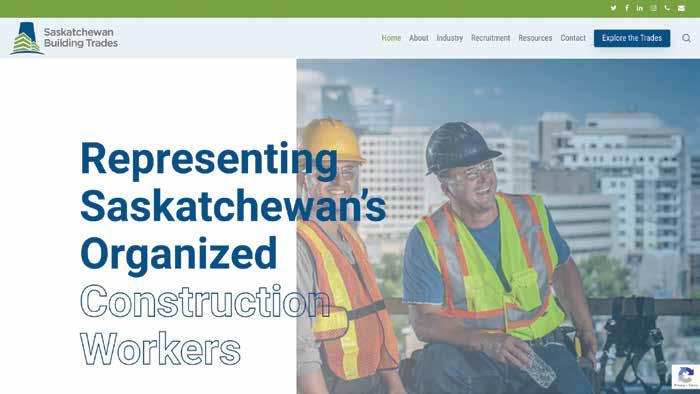
Helping Saskatchewan Building Trades pull the website together was
the digital marketing company Above the Fold. Based out of Regina, but with clients around the world, Above the Fold is a small team of online specialists who focus on web design, content creation, localized SEO, and social media curation, all with a heavy emphasis on businesses serving the trades, such as – but not limited to –general contractors, plumbers, and electricians.
“Dion (Malakoff) contacted me out of the blue; I think our first conversation was a text where he said ‘Hi my name is Dion. We need a website. Can we meet?’” laughs Barb McGrath, Founder and Managing Director at Above the Fold. “Of course, since then we’ve gotten to know each other, seeing as our kids are about the same age and play in the same hockey league.”
Given the large number of potentially impacted stakeholders involved in the process, designing the website took about six months – a little longer than usual for McGrath and her team. But because everyone wanted the final product to come out right, the extra time spent in collaboration was well worth it.
From the beginning, Saskatchewan Building Trades gave Above the Fold the freedom to do what it needed to do, so long as the final product was easy to navigate and increased the awareness of careers in the trades, especially among those in the 35-and-under age bracket – the future of the trades.
“Dion really wanted to ‘up the game’ for Saskatchewan Building Trades, allowing the association to play in the
26 Saskatchewan Building Trades
big leagues and represent its members as professionally as possible,” says McGrath. “He felt it was important that when a member or potential member went to the site, they could find the information they needed quickly and easily. It had to be simple.”
Almost everyone has heard the saying that “What goes on the Internet, stays on the Internet.” And while this can be true for old Tweets and Facebook posts, fortunately there are ways to remove content. It just requires the knowhow. This was actually one of Above the Fold’s most significant challenges in developing the new site, taking the old website down and scrubbing the Internet of old – sometimes misleading – content.
“Some of the content needed to be brought up to date and, in other cases, the content was just outright incorrect at this point, so it had to be removed,” says McGrath. “We needed to ensure that, when someone did a search on Google for example, they would be directed to the new site and old content wouldn’t appear anywhere.”
In addition to many of the front-andcentre features typically found on association websites, such as member information and resources, the new Saskatchewan Building Trades site links to a supplementary micro-site called “Explore the Trades”, where construction union organizations across Canada are helping the next generation of potential tradespeople understand what a career in the trades might look like, and then help them plan their construction careers.
“This kind of career exploration is something that’s unique to the trades,” says McGrath. “Maybe you’re interested in being a teacher, there’s no place to go to do this level of interest-based
testing. This new feature differentiates Saskatchewan Building Trades’ website from any of its workforce competitors.”


Over the last year, Above the Fold has also upped Saskatchewan Building Trades’ presence on social media platforms, both old-school platforms like Facebook and Twitter, as well as posting to emerging, video-heavy platforms like Tik Tok and Instagram Reels. The intent of this push is less about driving traffic to the website, but rather to build a greater awareness about the trades among those who need to hear about the trades the most.
“I really do give Dion a lot of credit for his forward thinking in terms of where his mission will go in the next decade, and beyond,” says McGrath. “He recognizes that, even though his members right now may or may not be active on social media, his future members, union employees, and workers currently live their lives on social media. For the next generation – social media has become their hobby – and it’s one of the best ways to reach them to talk about the trades.”

27 Building Saskatchewan
New thinking needed to address Saskatchewan’s labour challenges
By Bill Ferreira, Executive Director, BuildForce Canada


As it enters the fourth quarter of 2022, construction in Saskatchewan is performing at or near record levels in several key metrics.
The value of building permits issued in the province for the first eight months of the year, for example, is tracking about 39 per cent higher than it did through the end of August 2021. Meanwhile, in August 2022, levels of construction investme nt tracked more than 87 per cent higher than they did in the same month in 2021. For the first eight months of 2022, nonresidential construction investment levels were 31.2 per cent higher than they were through August 2021.
None of this is surprising. In our 2022–2027 Construction and Maintenance Looking Forward report for Saskatchewan issued last spring, BuildForce Canada projected provincial construction volumes to remain on a post-pandemic upward curve through at least 2023.
Although new residential-construction activity is being somewhat curtailed by rising interest rates, major publicsector expenditures in healthcare, education and road, highway, and bridge projects are being supplemented by a recovery in commercial-sector construction, and the start of major projects such as the Canada Jansen Potash expansion, the Cargill canola processing plant in Regina, and the Great Plains Power Station natural gas plant in Moose Jaw.
The challenge for the industry is not where to find work, but rather: where to find people to perform the work.
Labour markets are constrained and are complicated by demographics
No matter where you look in Canada today, labour markets are constrained. Between May and September, the size of
the total all industries labour force and the labour-force participation rate have both trended downwards.
At the end of the second quarter, employers across all sectors of the economy were actively looking to fill 997,000 vacant positions. Construction employers were looking to fill nearly 83,000 of those positions. Both figures are among the highest on record.
Meanwhile, at 3.1 per cent, the construction industry’s national unemployment remains near historically low levels.
Saskatchewan’s construction labour market remains similarly taxed, with employment approaching pre-pandemic record highs in July and August, and unemployment trending as low as 1.6 per cent over the summer months.
Through 2027, BuildForce Canada anticipates that nearly 5,000 workers, or 13 per cent of Saskatchewan’s 2021 construction labour force, will exit the workforce through retirement. The industry will need to recruit an additional 1,100 workers over the same period to sustain projected levels of activity.
Typically, the industry would look to alleviate most of its hiring requirements by recruiting new entrants under the age of 30 from the local population. Based on historical trends, the industry is expected to draw in an estimated 5,260 new workers by 2027. Compared with total hiring requirements, this may leave Saskatchewan’s construction sector with a gap of about 860 workers to be filled from outside its local labour force.
Demography is complicating that challenge. Although Saskatchewan’s population is younger than the national average, it faces similar challenges with respect to an
28 Saskatchewan Building Trades
aging workforce that is not being backfilled by a younger generation. The cohort of the provincial population aged 14 years or younger (i.e., those poised to enter the construction workforce in the next 15 years) is shrinking as a percentage of the overall population. In 2001, that cohort accounted for 21 per cent of Saskatchewan’s population; by 2021, it had declined to 20 per cent.
Meanwhile, the percentage of those nearing retirement age (i.e., people aged 50 to 64 years) increased from 14 per cent in 2001 to 18 per cent in 2021. Looking further ahead, the percentage of those in the core working age group (aged 25 to 49) declined by two percentage points (35 per cent to 33 per cent) over the same period.
All these indicators point to an underlying trend: Saskatchewan’s population is aging at a rate faster than can be sustained by younger demographics. For the construction industry, this points to the need to consider new solutions to an already-entrenched labour force challenge.
New solutions needed
BuildForce Canada has consistently advised of the need for the construction sector to broaden its recruiting strategy to attract more workers from three consistently underrepresented groups: women, Indigenous Peoples, and newcomers to Canada.
This last group in particular has been a reliable source of new, well-trained labour additions. Even as recently as during the Great Recession of 2008 to 2009, Canada was able to access immigrants and temporary foreign workers from the United States as well as countries further afield as the United Kingdom, Ireland, and Germany to supplement our domestic labour force and keep pace with construction demands.
This option could be restricted in 2023, however.
Construction in the United States, for example, is as busy, if not more so, than here in Canada. It too is pulling available workers from outside the country to compensate for labour shortages. In Europe, unlike during the Great Recession,
market conditions have held up creating less of a push on construction workers to consider employment abroad. Consequently, Canadian construction firms have become far more challenged in accessing foreign skilled trade workers as a supplement to the domestic workforce from these nations than they were during previous periods of aboveaverage domestic labour force demand.
What, then, is the way forward?
Flexibility will have to be the answer. The industry must continue to diversify. Domestically, it must continue to promote the recruitment of workers from outside traditional channels. At the same time, it must also look to enhance its recruitment of newcomers, refugees, and prospective immigrants to Canada.
A strategy that targets both elements could yield strong gains. The federal government through the Canadian Apprenticeship Service is increasing employer supports for the training of first-year apprentices, with supports doubling for the training of individuals from groups historically underrepresented in the Canadian construction industry.
At the same time, provinces and the federal government are engaged in discussions to increase the supply of foreign trained skilled workers, both through the selective use of the Temporary Foreign Worker Program (TFW), as well as reforms to the immigrant selection process. Although these discussions are still in their infancy, the industry must continue to press for these reforms, particularly for pathways for TFWs to permanent residency in Canada in order to ensure that construction continues to recruit its share of immigrants to Canada, which due to the country’s demographics, will make up a larger share of the overall workforce in the years to come.
Construction’s unprecedented labour-force challenge is not insurmountable, but it absolutely requires new thinking, persistence, and an increased focus on recruitment and retention by employers across the country.
29 Building Saskatchewan
All these indicators point to an underlying trend: Saskatchewan’s population is aging at a rate faster than can be sustained by younger demographics. For the construction industry, this points to the need to consider new solutions to an already-entrenched labour force challenge.
Advancing women in the trades
By Paul Adair
Before spreading out to offices across Canada, the Office to Advance Women Apprentices first started in Newfoundland & Labrador in 2009 with the goal of engaging and supporting tradeswomen working in construction trades.
Currently, the national average for women in trades remains at four per cent, while in Newfoundland – thanks in large part to the efforts of the Office – the provincial average has significantly risen to 13 per cent.
Looking to replicate and then build on the success of the Newfoundland Office model, the federal government provided funding to set up five additional offices across the country in Nova Scotia, New Brunswick, PEI, Manitoba, and Saskatchewan.
“I have seen many women start their skills training and even find employment but, for a variety of reasons, they leave the trades,” says Vanessa Miller, Project Coordinator for the Office to Advance Women Apprentices SK. “A resource like the Office is another avenue to keep women moving towards that Red Seal or success in trades careers, which provide good wages to support yourself and your family and job satisfaction where you can gain confidence, specialization, pride in work, transferable skills, challenges, and advancement.”
The Saskatchewan Office to Advance Women Apprentices provides wrap-around support to the province’s tradeswomen clients, which directly influences involvement, retention, and advancement of women in their trade careers. This includes personal counselling to the trades available, market research for job success, resume and interview development, Red Seal Preparation, or even just a listening ear and keeping tradeswomen in touch with what other organizations are doing or various opportunities that may be available.
“The need for an office is such that it is a central connection to all things trades for women,” says Miller. “Having a personal connection to each of the tradeswomen ensures they are getting everything they need to stay in their trade, as well as to be happy and successful. We work together to find ‘a good fit.’”
The Office does this by identifying the needs of the tradeswomen and then coordinating with partners in industry to fill that need, such as with a course or certification, offering personal counselling and encouragement to register for courses or events, and creating opportunities to connect with other tradeswomen.
In 2000, Saskatchewan’s average for women in trades was four per cent. And now, more than 20 years later, we have seen those numbers rise to only six per cent. Still, there is optimism, and the Office is starting to see “needle” move forward.
“We’re seeing lots of interest from women and, in four years and through a pandemic, we have had 270 women register with the Office with skill levels ranging from being interested in trade opportunities to experienced trades women,” says Miller. “And while it has been a slow process to create the network, we have established relationships with industry and partners and are making new connections at every opportunity. We’re constantly growing our network and finding skills and employment opportunities for our tradeswomen.”
In addition to building connections between tradeswomen and industry, the Office to Advance Women Apprentices SK also coordinates with the other sister Offices across the country. The various Offices collaborate to share information and expertise and help women if they’re relocating between provinces.
As well, each Office uses the same database structure format, with the content is privatized for each province. The Offices also all share a universal website (with a page for each province), a universal texting program for client outreach, and a universal job board system.
Under the umbrella of the Canada’s Building Trades Union (CBTU), the Office works alongside the Saskatchewan Building Trades on any of their initiatives that seek to make the trades more welcoming for women in the province.
30 Saskatchewan Building Trades
What people are saying about the Office to Advance Women Apprentices SK:
“If it weren’t for the Office, I wouldn’t have been able to go to school like I did with the success that I did, and I wouldn’t have been able to get the job that I have now. My husband and I just bought a house a few months ago, and that was something we always thought was completely out of our reach. I owe a lot to the Office to Advance Women Apprentices SK.”
“Through their social gatherings, I get to know women in other trades. We understand each other and what it means to stand alone as a woman in the shop. These are other women who can relate to you.”
“We work directly with the unions by making connections to tradeswomen and counselling the tradeswomen about such things as unions, work scope, and expectations,” Miller says. “We work behind the scenes to get women into unionized jobs where the pay is better, and for them to avail of other supports the trades unions have to offer.”
If you are a contractor, tradeswoman, or woman exploring the trades, you can register with the Office to Advance Women Apprentices SK by going to the Office’ website

“A staff member from the Office has been the one that’s been emailing me, checking in on me, sending me programs. She called me last Friday to ask how everything was. I never really had that before – somebody who actually cares and wants me to succeed.”



“They have meetings and nights with pizza, and everybody gets together in-person. You just hang out, sit on the couch, and everybody gets to know each other. I know a trades lady. I know a welder. I know a carpenter. It’s not just the trade; it’s like your whole community.”
– www.womenapprentices.ca – and follow the link to the Saskatchewan page.








“If you’re an employer or organization, keep lines of communication open,” says Miller. “Let us know what you are doing, what you need, what you offer, and we will get the word out! And if you are a women interested or experienced in trades: get involved and become a mentorship ambassador.”

31 Building Saskatchewan
DIGITAL BOARDS SIGN CABINETS TRAFFIC SIGNS WINDOW GRAPHICS NEON LETTERS PYLONS
Mentorship matters
The Canadian construction industry is expected to lose more than 250,000 skilled tradespeople to retirement in less than a decade. Mentorship is one of the most important elements in workforce development. Approximately 80 per cent of all training in the trades and technical sector takes place on the job through mentoring relationships, and industry relies on the mentor-apprentice relationship to help develop qualified journeypersons.
“Mentorship has long been recognized as an effective means of knowledge transfer; a way to pass on important skills to the upcoming generation, and to produce productive, highly skilled, and safe workers,” says Kyle Downie, CEO of SkillPlan. “Mentorship is a key factor in developing a qualified journeyperson.”
Yet, there is significant variability in how mentoring takes place. Just because someone is a great tradesperson doesn’t necessarily mean they are good at mentoring. Generally speaking, not all journeypersons have taken training or received guidance on how to be effective mentors, and the construction industry’s traditional mentorapprentice relationship can use support to ensure that consistent knowledge is transferred from skilled to unskilled workers.
Additionally, with today’s diverse and changing workforce,
industry needs good mentorship to support, motivate, encourage, and create more supportive work environments for new workers. Skills development leverages the demographic shift, and mentoring – when done right – helps reduce the onboarding time for new workers and has a positive impact on helping them become more effective, thereby ensuring a stronger, safer, and better industry.
“Through effective mentoring, apprentices can learn to be the best from the best,” says Downie. “Good mentoring takes skill and expertise. The passing on of knowledge from one generation to the next will become increasingly necessary for apprentices to thrive in their training, their jobs, and their ability to take on new roles.”
SkillPlan recognizes the need for good mentors and has been working with the construction industry to implement mentorship programs during technical training and employment.
BuildForce and SkillPlan, along with Social Research and Demonstration Corporation, partnered to undertake an Employment and Social Development Canada-funded initiative to develop and implement an innovative mentorship training model to ensure workers can improve their skills to gain and maintain a job, and to better adapt and succeed at work.
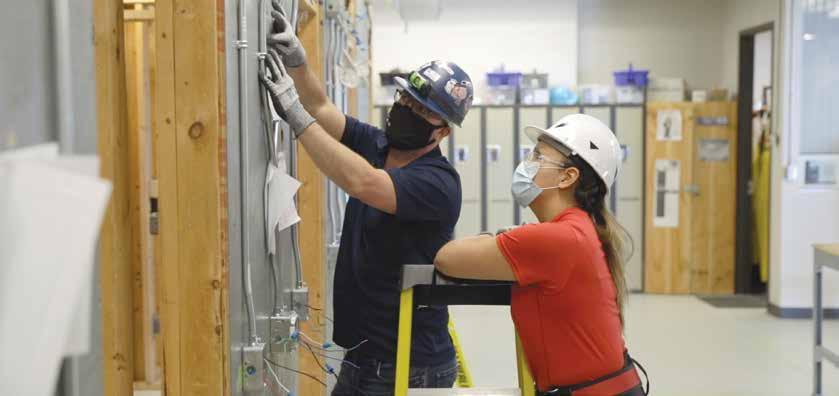
32 Saskatchewan Building Trades
PHOTO COURTESY OF SKILLPLAN
This program is aligned with – and endorsed by – industry, and includes mentorship training for apprentices and journeypersons, train-the-trainer training, and on-thejob training to monitor and reinforce good mentoring. The project also involves a return on investment (ROI) analysis to evaluate the benefits of the program on the workforce, including improvements in safety, productivity, quality, and the on-time, on-budget delivery of industrial, commercial, and residential projects.




“Based on extensive feedback from the construction industry, the primary goal for this project was to develop, implement, and evaluate a mentorship training model that will address skills and performance gaps on the job,” says Downie.
Current research results are showing positive trends in safety, productivity, and quality of work with contractors who have embraced this mentorship training for their workers along with a minimum ROI of approximately for every dollar you invest in the program you get two dollars in return.
To learn more about our mentorship programming, please visit us at www.skillplan.ca.

33 Building Saskatchewan
Proud to be a Saskatchewan industry leader since 1958. For additional information on member and employer benefits call us at: 306-757-5482 www.local296.ca • 1-888-795-8296 WE OFFER OUTSTANDING PERSONAL SERVICE AND QUALITY IN THE AREAS OF... • Creative Design • Website Design • Advertising Sales • Trade Publications • Online E-newsletters • Qualified Sales & Editorial Team www.delcommunications.com Helping your members stay connected is WHAT WE DO.
Saskatchewan Indian Institute of Technologies innovates in the trades
pathway, diploma, and apprenticeship level programs – from carpentry to welding, electrical, concrete forming, heavy equipment operation, pipe insulation, construction, power engineering, aircraft maintenance engineering, and more.

In 1976, First Nations leaders in Saskatchewan had a groundbreaking idea to provide Indigenous-led education and training to Indigenous students across the province.
Over 45 years later, the Saskatchewan Indian Institute of Technologies (SIIT) is one of four accrediting postsecondary educational institutions in Saskatchewan, providing academic, technical, and vocational training, as well as services and supports for employment and career growth.
With a provincial footprint of three campuses, nine Career Centres, over 30 community-based learning sites, and two mobile program delivery units, SIIT continues to innovate in their approach to programming,
meeting industry needs and exceeding standards of program development, while ensuring an environment rooted in Indigenous culture where traditional knowledge is shared, and language and culture are nurtured.
SIIT has a long history of delivering programming that is innovative, driven by market need, and that supports workforce development and capacitybuilding in Indigenous communities across the province. Engagement with community and industry partners is an ongoing and key part of SIIT’s approach to developing and delivering marketrelevant training.
The Saskatchewan Indian Institute of Technologies is proud to offer a wide variety of trades and industrial
SIIT is the only educational institution in Saskatchewan to offer the Aircraft Maintenance Engineering program. A unique, two-year diploma program delivered at the Saskatoon Aviation Learning Centre, students develop the skills required to troubleshoot, maintain, and repair aircraft in accordance with Transport Canada’s standards of safety and performance. Given the increasing demand for skilled aircraft maintenance engineers in the growing aviation and aerospace sector, SIIT’s graduates are highly sought after, with many being offered employment prior to graduation.
In response to the growing demand for skilled power engineers in Saskatchewan and beyond, SIIT is proud to offer both 3rd and 4th Class Power Engineering programs, with steam time training being completed at the boiler lab in Meadow Lake. Proven to be a key part of ensuring a seamless transition from training to employment and a highlight of the program for many students, the state-of-the-art facility provides integral hands-on
34 Saskatchewan Building Trades
experience to reinforce what is taught in the classroom.
Always responsive to economic demand, SIIT is also engaged with the plant-based food and ingredients industry, one of Canada’s fastest growing sectors. To support with meeting the growing global demand for plant-based protein and helping to fill the significant labour shortage gap that currently exists, SIIT developed the Agri-Food Processing and Introduction to Indigenous Agriculture programs, in partnership with industry and community partners. Both programs are vital to cultivating and supporting Indigenous innovators as they contribute their talents and expertise to Canada’s food processing sector and will ensure that they are equipped with the skills and training necessary to succeed and contribute to future economic growth in a meaningful way.
Driven by market need and in response to the challenges and gaps identified by industry and community partners, SIIT’s Trades and Industrial programs equip learners with the skills and experience deemed necessary by industry to successfully transition to employment.


For more information and a full list of program offerings, please visit www.siit.ca.
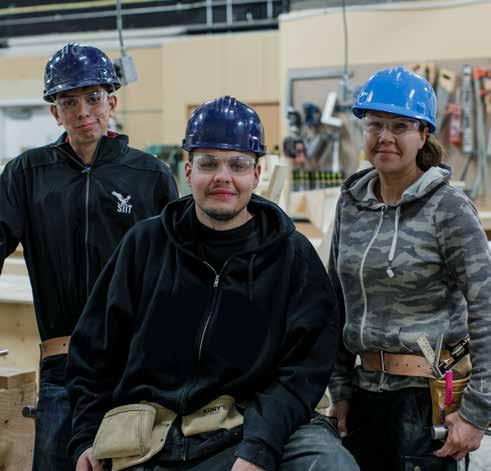
35 Building Saskatchewan Take the Next Step! BUSINESS & TECHNOLOGY HEALTH & COMMUNITY STUDIES TRADES & INDUSTRIAL ADULT BASIC EDUCATION “Yunadhe dįt’eth” “Ahkami pimohtē” “Ċdehde iyokpiya icupi” SIITLive www.SIIT.ca
There’s a great future in the trades
By Dr. Larry Rosia, President and CEO, Saskatchewan Polytechnic

those responding to 3M’s survey must have some idea of the quality of pay for tradespeople. Eighty-one per cent of respondents believe they would earn as much money in a skilled trade as they would in a career that requires a degree from a traditional four-year university or college.
But there are other benefits to pursuing a trades career. Some tradespeople go on to own their own businesses and pursue other entrepreneurial ventures.
There is a great scene in the 1967 film classic The Graduate where a family friend corners the main character, Ben (Dustin Hoffman), at a party and offers this advice: “There’s a great future in plastics.”
Movie buffs will tell you such advice was meant to signify everything uncool to a 21-year-old like Ben, who just graduated from university.
If The Graduate were being made today, a similarly “uncool” piece of advice would be this: There’s a great future in the trades.
A new and revealing study by 3M Canada indicates that despite thinking highly of skilled trades and the professionals who work in them, 76 per cent of Canadians say they would never pursue a skilled trade for themselves.
This is mind-boggling, especially when you consider that tradespeople are not
only in huge demand across so many vital industry sectors, but that they are also highly employable – something evident not only in Canada but in many other countries as well. Even the respondents to the study acknowledge this; 92 per cent believe “there is a lot of opportunity in skilled trades.”
What’s more, tradespeople can earn very attractive salaries.
For example, pipefitters and heavyduty equipment technicians with four years’ certification had a median income of more than $100,000 in 2018, according to data from ImmigCanada, an immigration consulting firm. As well, skilled and qualified electricians in Canada can easily earn between $80,000 and $90,000 in a year – more than twice the median income for Canadians.
Again, an overwhelming number of
So, what will it take to take to get more Canadians – those just graduating high school and those who have been in the workforce for several years – to actively commit to a career in the trades?
It is no secret that skilled tradespeople are in high demand right now. In Saskatchewan alone, the top indemand skilled trades are automotive service technician, boilermaker, bricklayer, carpenter, cook, hairstylist, refrigeration and air conditioning mechanic, sheet metal worker, and steamfitter/ pipefitter and welder, according to the Canadian Apprenticeship Forum.
The shortage of skilled tradespeople is not going away anytime soon. According to the Government of Canada, approximately 700,000 skilled trades workers are expected to retire between 2019 and 2028.

36 Saskatchewan Building Trades
I believe polytechnics are key to helping fill the talent pipeline.
Offering hands-on training that industry needs and wants is one of the things that differentiates polytechnics such as Saskatchewan Polytechnic from other institutes of higher education. When it comes to the trades specifically, Sask Polytech provides the in-school portion of apprenticeship training for 20 trades. In fact, the institution offers training for nearly all the in-demand skilled trades listed by the Canadian Apprenticeship Forum.
At Sask Polytech, students are trained by industry professionals and our trades curriculum is developed and designed in consultation with industry experts. Also, our trades training facilities are innovative spaces with specialized equipment that encourage learners to work in multi-disciplinary teams.
Recruiting tradespeople is critical to the future of Canada’s economy and our future prosperity.
Education is one way to recruit new learners. By this I mean educating both students and high school guidance counselors, so they understand that lucrative and rewarding trades careers exist for young people.
Another way is through programs like Sask Polytech’s Women in Trades and Technology (WITT) program, which has seen an increasing number of women joining the trades and making their way onto building sites and shops across Canada for over 30 years.
There are also other programs at Sask Polytech to encourage underrepresented groups including women, Indigenous peoples, newcomers, people with disabilities and youth to explore opportunities and start
careers in the trades to better support a skilled, inclusive, certified and productive workforce.
In addition, Sask Polytech’s School of Continuing Education offers a number of Industry & Trade courses designed for those in the workforce who want to upskill or reskill.
While polytechnics are important, however, they are only part of the solution.
As Terry Bowman, Manufacturing and Supply Chain leader at 3M Canada, points out, businesses also have a role to play.
“It is imperative Canadian organizations provide equitable access to STEM education to passionate young Canadians interested in pursuing a skilled trade,” he says.
It also helps when businesses step up to sponsor apprentices or partner with post-secondary institutions on work-integrated learning to offer opportunities to learn about a career first-hand. For example, 30 high school students from across Saskatchewan
took part in an in-person agricultural boot camp last December through a partnership with Canada Equipment Dealers Foundation, Sask Polytech, Sun West School Division and the Western Equipment Dealers Association.
Imagine if every business across Saskatchewan and western Canada that employs tradespeople committed to similar initiatives to foster interest in the trades.
There would be several benefits. Companies could highlight what they have to offer while establishing relationships they could carry forward as students and apprentices continue their education journey. This could open pathways into the labour market which may otherwise not have existed or been accessible.
While this approach would not immediately fix the shortage of skilled tradespeople, it would certainly put a big dent in it. And it would go a long way to showing Canadians of all ages that there is, indeed, a great future in the trades.

37 Building Saskatchewan
Canadian CCS leadership: An opportunity too important to lose
 By James Millar, President and Chief Executive Officer, International CCS Knowledge Centre
By James Millar, President and Chief Executive Officer, International CCS Knowledge Centre

With the world in the grip of the first truly global energy crisis, millions of people are bracing for a winter that is expected to be marked by power brownouts, heating fuel shortages, and widespread economic recession. Skyrocketing energy prices sparked by Russia’s invasion of Ukraine at the same time as global demand entered a post-pandemic rebound are having devastating consequences. In the
United Kingdom, for instance, threequarters of the country is expected to enter energy poverty by the new year, and countless families are facing the stark choice between spending money to keep warm or having enough to eat.
It’s a painful example of the real-life difficulties of trying to balance the world’s growing demand for reliable, affordable, and responsibly produced energy while simultaneously working
to meet ambitious goals for cutting GHGs. There are no easy answers for how these competing objectives can be achieved over the next few decades, but it is increasingly clear that if we have any hope of meeting the aggressive emissions reductions required by the Paris Agreement to avoid catastrophic levels of climate change, an “all of the above” strategy is required.
38 Saskatchewan Building Trades
SaskPower’s Boundary Dam Power Station and the CCS facility (to the right of the power plant).
While the immediate impacts of the current energy crisis may not be as acute for Canadians, the long-term challenge is a daunting one, as our lifestyles are energy intensive and our economy is founded on heavy-emitting industries that provide the products and resources the rest of the world desires. At the same time, our national climate targets aim to neutralize carbon emissions from our electricity sector by 2035 and reach net-zero emissions across the country by 2050.
Thankfully, many of the technologies that will help us get there are already in play in Canada – including a key solution in which we are a world leader – carbon capture and storage (CCS).
CCS is a suite of technologies that can be applied to a variety of industries and applications. Deploying CCS involves
complex engineering, but the concept is simple: capturing the carbon dioxide that is the by-product of burning fossil fuels and storing it far underground so it cannot enter the atmosphere and contribute to global warming.
Respected international organizations including the UN’s Intergovernmental Panel on Climate Change and the International Energy Agency agree that it will be virtually impossible to meet the critical emissions reduction targets needed to avoid dangerous climate change without significant expansion of large-scale CCS. It is seen as a pillar of the long-term transformation of the energy system because it enables deep and rapid emissions cuts to many of the largest emitting industries, as well as the potential for removing large amounts
of CO 2 directly from the atmosphere after it has been emitted from a smokestack or a tailpipe.
Using equipment and processes that are already proven successful over the last 20 years, CCS serves as an important bridge by removing the climate impacts of fossil fuels in a cost-effective manner while the world undertakes a massive expansion of renewables and other energy alternatives such as nuclear and hydrogen.
Canada has been a leader in the first generation of CCS. We are home to five of the world’s 30 commercial CCS facilities, and we account for approximately 15 per cent of current global CCS capacity even though our country generates less than two per cent of global emissions.

39 Building Saskatchewan
Inside the Boundary Dam Unit 3 CCS facility.
Our experience includes several projects that were the first of their kind. SaskPower pioneered the world’s first commercial CCS facility on the Boundary Dam coal-fired power plant, which began operation in 2014. The facility has safely prevented nearly five million tonnes of CO 2 from entering the atmosphere – the equivalent of taking 1 million cars off the road for a year. Meanwhile in Alberta, Shell’s Quest project has captured more than six million tonnes from an oil sands refinery since 2015, and the Alberta Carbon Trunk Line, the world’s largest CO 2 pipeline, transports emissions from a refinery and a fertilizer plant for industrial use and underground storage.
These projects are models for the next generation of CCS being planned around the globe. They provide valuable lessons that the Regina-based

International CCS Knowledge Centre is leveraging to help companies develop new facilities with the potential to safely capture and permanently store more CO 2 at a lower cost than what has been possible to date.
Canada’s latest climate plan calls for more than tripling the country’s CCS capacity over the next decade. It is expected to play a central role in eliminating emissions not only from the oil & gas sector, which accounted for 180 million tonnes of GHGs in 2020, but also the 115 million tonnes that come from power generation and other heavy industries. With more than 100 new projects in development worldwide, some estimate the CCS industry will grow to be a $55 billion/ year industry by 2030, and it’s expected to be responsible for 25 per cent of the emissions reductions required for the world to reach net zero
emissions by mid-century.
With this level of activity underway, it’s clear that Canada is uniquely suited to capture enormous value from the CCS boom on the horizon. But there must be strong collaboration between industry and government to move multiple billion-dollar projects forward quickly. There is much discussion about what the appropriate level of taxpayer support for CCS projects should be, and whether oil & gas companies should receive additional incentives while they are profiting from fossil fuels. These are important questions, and they must be considered with an understanding of the significant short- and long-term benefits that are at stake.
Most of the largest investments Canadian energy companies and their peers in other heavy industries are planning to make in the coming years are not in traditional growth projects. Instead, virtually all the country’s resource-based firms — from oil & gas, mining, and electricity to cement, steel, and fertilizer manufacturers — are looking to add large-scale CCS to their operations. More than a dozen projects are at various stages of development across the country, each one representing the potential for thousands of high-quality jobs for engineers, tradespeople, and suppliers over several years of construction; economic partnerships with local Indigenous communities, as well as ongoing employment for running and maintaining these industrial facilities.
In Alberta, the Pathways Alliance – a partnership of the six largest oil sands companies – plans to invest more than $22 billion in one of the world’s largest CCS projects and other emissions
40 Saskatchewan Building Trades
The International CCS Knowledge Centre’s Director of Project Development & Advisory Services conducting a tour of the BD3 CCS facility.
reduction technologies by the end of the decade. This is expected to generate 35,000 construction-related jobs, 1,000 permanent positions, and unlock more than $50 billion in GDP. Meanwhile, international cement producer Lehigh Hanson aims to build the world’s first full-scale CCS project on its Edmonton cement plant by 2026 — creating 800 full-time jobs and approximately 7,000 person-years of employment in the process.
These are tangible opportunities for families and communities that were borne out on the Boundary Dam Unit 3 CCS project in Saskatchewan, where 1,700 people were employed during peak construction and 5 million person-hours of employment was generated over almost four years.
SaskPower is now studying the retrofitting of additional coal and gasfired power plants with CCS, and global mining company BHP is examining the feasibility of deploying CCS at its proposed Jansen potash mine in Saskatchewan, which is expected to be the largest potash producing mine in the world.

Beyond the immediate economic benefits, there are broader long-term opportunities to leveraging Canadian leadership in the CCS sector. As we have seen with the first generation of CCS, the innovation and expertise created by clean technology projects is easily exported, and it’s in high demand as global climate action gains momentum. In tandem with this is the competitive advantage that can be realized by our industries being the first to supply the low-carbon commodities that can fetch premium prices in a decarbonizing world.
We are at a critical point, as world
emissions continue to grow, and Canada risks falling behind our competitors when it comes to getting CCS projects off the ground. The investment tax credit included in Canada’s most recent federal budget is an important step toward mobilizing private capital to invest in CCS, but it is a substantially lower level of support than the programs now in place in the U.S., the United Kingdom, and Norway.
Depending on the regulatory process and the ability to purchase equipment and hire workers, it takes about six years to bring a large-scale CCS facility to life. This means it is imperative that companies in Canada receive the business certainty they need to move forward on the timeline required to meet our climate obligations.
As with other critical industries, we must seek to ensure our approach to CCS development is aligned with our peers in order to encourage private-sector investment in these mega-projects across international borders. The landmark incentives for CCS projects now in place in the United
States promise to make the world’s second-largest greenhouse gas emitter a world leader when it comes to the next wave of CCS development. The comprehensive incentives contained in the U.S. Inflation Reduction Act passed this past summer provide valuable guidance to our federal government while it is in the midst of developing a national strategy for CCS.
We know that bringing Canada’s strong commitment to fighting climate change to reality will not be easy, but we have the home-grown expertise necessary to continue playing a leading role in this exciting area. Capitalizing on this opportunity is critical to ensuring our energy transition doesn’t destroy the vital industries that are the lifeblood of communities across the country. Instead, CCS enables a just and sustainable transition by making our heavy-emitting industries part of the solution. Let’s make sure we don’t miss out on such a monumental opportunity.
Learn more at ccsknowledge.com.
41 Building Saskatchewan
Close-up of the outside of the CCS facility.
SMART: Celebrating 70 years of roofing in Canada
By Chris Paswisty, Director of Canadian Affairs
The Sheet Metal Workers’ International Association (SMWIA, now SMART) began organizing roofers in the Toronto area in the early 1950s. It seemed like the perfect marriage, as sheet metal workers were already organized in most of the roofing shops. The roofers worked long days with no benefits, poor working conditions and sub-par wages — $1.20 per hour at the time.
It was Thursday, November 12, 1952, when roofers in Toronto held their historic meeting and reported that union certification had been received at four firms: Cloke Construction, Apex Roofing, Heather & Little, and A.E. Furnival. Roofers who worked for R.S.C. Bothwell, the Board of Education, and Plewman were also
present at the meeting. A motion was made that a committee investigate roofer classifications and draw up a collective agreement.
On the following evening, November 13, the inaugural meeting was held, and the first SMWIA roofing officers were elected. The new roofer representatives were President Wm Munroe, Vice President Sandy McLeish, Financial Secretary J. Johnson, Recording Secretary R. MacMahon, Warden F. Guerin, and Conductor L. Cadieux. This was the beginning of 70 years (and counting) of solidarity and craftmanship in the roofing industry, with union members standing shoulder to shoulder and working diligently to represent the best interests of these
skilled workers. Today, almost every local in Canada has roofers in its membership.
Our roofers are skilled tradespeople who install a waterproof membrane on buildings that have either a flat or sloped deck consisting of wood, steel, or concrete. They specialize in residential, industrial, commercial, and industrial roofing. The systems are conventional tar and gravel, two-ply SBS, inverted roofing systems, EPDM, and single-ply PVC. It is also common to use a simple ply rubber membrane that is laid over rigid board insulation or to use rolls of modified bitumen paper applied by using a propane torch and melting the product over a flat surface.

42 Saskatchewan Building Trades
Green roof.
Green roofing is now populating the skyline. Builders are installing green roofs on their projects not just because they are visually appealing, but to help reduce greenhouse gases and to improve air quality. As the government looks to reduce emissions and retrofit buildings, the roofing sector will continue to thrive.
The Infrastructure Health & Safety Association’s (IHSA) Roofing Trade Committee has been active in producing safety manuals and public periodicals to help keep roofs and workers safe. The committee’s work includes a health and safety manual, heat stress brochures and advisories on roof openings and skylights. The roofing industry is constantly changing, and SMART and its members are committed to organizing and
improving the health and safety of all roofers.





Today our members provide their services for new roof construction, roof repair, restoration, maintenance, and roof replacement using the most up-to-date methods and roofing technologies. Every two years, a
national roofing apprenticeship competition is held, where roofing members from all over Canada come together to compete and showcase their skills.
We’ve come a long way in 70 years. Congratulations on seven decades of solidarity!
Building the Future Together
At SMART Canada, our members are qualified professionals and certified tradespeople dedicated to all aspects of roofing, architectural cladding, custom sheet metal and complete ventilation systems. We partner with our signatory contractors across Canada to supply generations of hands-on experience and a commitment to safety on every project.


Our sheet metal members fabricate and install proper ventilation and air filtering systems to ensure the overall health of our schools, offices, hospitals and homes. Our roofing and architectural members play a vital role in the building envelope by enhancing and protecting your investments. Together, we are building healthy communities for a better tomorrow.
We look forward to working with you on your next project. Contact us by email at info@smart-union.ca or call (877) 788-1288.

43 Building Saskatchewan
Training • Safety • Quality • Reliability • www.smart-union.ca
Conventional tar and gravel.

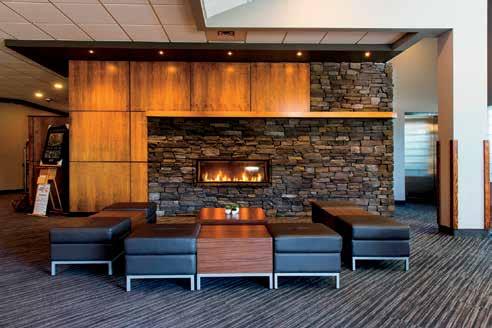









44 Saskatchewan Building Trades Features & Amenities In-room safes Air conditioned rooms Pool, hot tub,& water slide 50" HD TV in rooms Parking lot monitored by security all night, every night Ample desk/work space in every room Lulu's Kitchen on-site Contact 140 Marquis Rd W Prince Albert, Sk (306) 922-5000 BOOK NOW www.painn.com Promo code: SBTC for 15% off S A V E $ $ $ S A V E $ $ $ O N O N H O T E L S I N H O T E L S I N Calgary • Medicine Hat • Calgary • Medicine Hat • Red Deer • Regina Red Deer • Regina www.BookABusiness.ca www.BookABusiness.ca G E T R A T E S G E T R A T E S F O R F O R C R E W H O T E L S C R E W H O T E L S I N I N Saskatoon • Regina • Swift Current Saskatoon • Regina • Swift Current Yorkton • Medicine Hat Yorkton • Medicine Hat HOTEL GUIDE ----






Gold Eagle Lodge 12004 Railway Ave E North Battleford 306-446-8877 reservations@goldeaglelodge.com Conveniently located off Yellowhead Highway 16 West. Full hot breakfast Pool, hot tubs, sauna, and steam room. Many room type options available for every need.












46 Saskatchewan Building Trades The perfect location to stay active in a wellness-focused hotel $17M Renovation Complete 20,000+ Sq Ft of Meeting Space 290 Guestrooms Heated Underground Parking The Delta Pantry for Elite Marriott Bonvoy™ Guests The Grind Coffee Bar Proudly Serving Starbucks® Coffee Aroma Restaurant 1,400 Sq.Ft. Fitness Center Indoor Waterpark An unparalleled perspective of Saskatoon 15,000+ Sq.Ft. of Meeting Space 225 Guestrooms Five Acres of Lush Gardens Garden Court Café Stovin's Lounge 24-Hour Fitness Centre Pool, Whirpool, Sauna On-site Spa Saskatoon's Castle on the River ouble? Seeing Two hotels, one contact Stay at Saskatoon's two most prestigious riverview hotels 515 Total Guestrooms 35K Total Sq.Ft. Meeting Space For project and crew rates, contact: Keefe Sherstobitoff Market Senior Sales Executive 306 262 5337 keefe sherstobitoff@deltahotels com Receive 10% off your stay using promo code T9665 with your Saskatchewan Building Trades Membership Marriott.com/YXEDS Marriott.com/YXEDB Amenities: • Lounge onsite • Complimentary full breakfast • Kitchenettes in all guest rooms• FREE, high-speed internet • FREE, exclusive loyalty program • 24- hour business center • Meeting rooms • Fitness center • Indoor swimming pool & hot tub• • Laundry facilities Airport Inn & Suites 317 Aerogreen Crescent, Saskatoon, SK S7L 1S4 P: (306) 986-1514 Reservations: 1 (800) 780-7234 www.bestwestern.com For business or leisure, there’s always a little something extra. 3551 - 2nd Ave. West | Prince Albert 306-764-6441 Nice Rooms. Great People Restaurant & Lounge Cold Beer & Wine Store Free High Speed Internet 5 Meeting & Banquet Rooms Group & Crew Rates Available Book Your Stay Today!
LARGEST
NETWORK.
UNLIMITED DATA. UNLIMITED WI-FI.
BUSINESS WIRELESS
Stay connected with customers and employees on Saskatchewan’s largest LTE and Wi-Fi networks.

• Unlimited Canada-wide data* usage with Business VIP plans
• No data overage charges
• Free unlimited Wi-Fi
• Unlimited text messaging in Canada, the US, and most of the Caribbean
• Flexible, competitive wireless plans built with your needs in mind
It’s the wireless solution your business needs.
*Speed reduced to 2 Mbps after 20 GB or 50 GB depending on chosen plan
sasktel.com/businessvip
INVESTING IN APPRENTICES IS INVESTING IN YOUR BUSINESS
Canada’s Building Trades Unions’ In The Trades apprenticeship program provides financial and training incentives for unionized Canadian contractors who hire, onboard and train new first-year skilled trades apprentices.
FINANCIAL & TRAINING INCENTIVES AVAILABLE
• $5,000 for hiring new first year skilled trades apprentices
• $10,000 for hiring new first year apprentices from equity deserving groups FOR MORE INFORMATION VISIT

BUILDINGTRADES.CA/INTHETRADES





































 Submitted by Saskatchewan Polytechnic
Submitted by Saskatchewan Polytechnic


 By Paul Adair
By Paul Adair



































 By James Millar, President and Chief Executive Officer, International CCS Knowledge Centre
By James Millar, President and Chief Executive Officer, International CCS Knowledge Centre







































